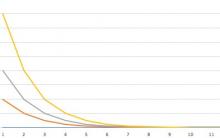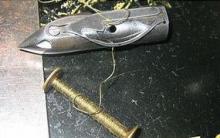The question is asked by Mullakhmetov Ildar:
Nikolay, hello. I looked through the site well, but found almost no information on the remnants of the goods.
The questions are:
- Using bags as an example, what is the average percentage of goods that cannot be sold?
- If this percentage is not zero, how do you deal with the leftovers? Promotions, special offers - how much does it reduce the% of the balance? There may be some case that allowed to seriously reduce the balance.
- I think that no matter how hard you try, you won’t sell everything, and even after promotions, etc. some dry residue remains, which settles as dead weight in the warehouse. What is he? Are there options for working with him?
Thank you in advance for your response.
Hello Ildar.
The remains of the goods are absolutely in every commodity business and almost impossible to calculate to do without them. I still have them in the store, but not a lot. Below I will explain why and where the leftovers go. I will answer your questions in order.
- If we count by batches of goods, then 10% always remains.
- To be honest, I never equated any goods with the leftovers, but only after your question did the calculation :) Accordingly, I never did anything to sell them. I'll explain why. In a short trading period (a year and a half), I concluded that any product will find its buyer. And in this I was not mistaken. It happens that even from the first order of goods, which was a year and a half ago, they buy bags now. Although there are only a few of them left, they are bought without any promotions, discounts and sales of leftovers. Therefore, if you are engaged in accessories or clothing, then you can safely leave these products in the window and they will be bought sooner or later. Below I will describe the working methods of selling leftovers.
- As I answered above, the remainder remains, but is still being sold gradually. Often there is a seasonal product (summer bags), but they are sold out the next summer.
Sale of leftover goods
Here are a few ways I see and have tried to sell leftover merchandise. They all work.
1. If you are selling through the site, then create a separate section with leftovers. You can call it "Sale". Post leftovers there and make discounts. But in addition to simple discounts, you can do this: "Buy 3 things and pay for 2." Thus, your balances diverge faster, and the benefit is higher than from a simple discount, for example, 40%. Because you're giving away 3 things for free that cost less than the other two. And for a person, this is much more pleasant than just a standard discount.
2. What works for me with a bang. I attach cheap goods free of charge to expensive goods. Thus, a person sees that for the same price as before, he can buy an expensive bag, but at the same time receive a wallet as a gift. As a result, I sell an expensive product that is rarely sold, but I also sell (albeit for free) a wallet that costs “dead weight”. The benefit is obvious, because the margin from expensive goods will more than cover the price of a cheap one. In essence, the method is similar to the first, but sometimes it is more attractive.
3. Place an ad on Avito that you sell your product in small wholesale. Make a small cheat, so as not to work in the negative and not to zero, and sell all the goods in bulk. 40 purses were bought from us before the New Year. One trucker decided to congratulate his colleagues and took them with him to Surgut. And he is pleased that he received it cheaply and we are pleased that we sold the rest and even a small plus.
4. Can be returned to the supplier. If you work with your supplier for a long time and he is not in China, then you can arrange a return. Many go for it. It makes no difference to them who to sell these goods to, you still order lots from them. The main thing is that the goods do not lose their marketable condition for a long time spent in the warehouse!
If your product is food, then only return to the supplier. But everyone in the food industry knows this.
5. If there are a lot of leftovers, then city fairs help. My friend who does confectionery, uses it very actively. At the end of the season, he has several tons of various candies left. So at the fairs, he actively sells them. You can also go to fairs in the nearest districts / villages. There they will be bought more actively, because the prices in stores are more expensive than in the city itself.
Conclusion
In conclusion, here's what I would like to recommend. Try to evaluate each item of the product that you purchase. We approached the product very responsibly, so there were few leftovers. We tested the goods before purchasing, we looked whether they would be bought from us or not. It's a tedious process, but it saves a lot of money in the end. Like this!
If you have additional questions, ask in the comments below;)
Sincerely, Schmidt Nikolai
A cookie is a small text file that is stored on your computer/mobile device when you visit a website. This text file may store information that can be read by the website when you visit it again at a later time. Some cookies are necessary for the website to function flawlessly. Other cookies are useful for visitors: they securely and securely store the username, such as language settings. Cookies ensure that you do not have to enter the same information each time you revisit a website.
What do we use cookies for?
We use cookies to offer you the best experience on our website. Through the use of cookies, we can ensure that you are shown the same information when you visit our website again. Cookies may also be used to optimize the performance of the website. They make it easier to browse the website.
Appropriate organizational and technical measures are taken to protect your personal data and to prevent loss of information or illegal behavior.
Why do we use third party cookies?
We use third-party cookies to analyze statistical information in prefabricated forms using analysis tools such as Google Analytics. For this, both permanent and temporary cookies are used. Persistent cookies are stored on your computer or mobile device for a maximum of 24 months.
How can I disable cookies?
You can very simply disable all cookies in your web browser settings. To do this, simply click "Help" and search for "Blocking Cookies". Keep the following in mind: if you disable cookies, that website will only show partially or not at all.
The next, summer, autumn, winter, spring season has ended. There is quite a lot of unsold goods left in the clothing store. A new season is coming, and with it a new fashion, other trends.
From year to year, the number of unsold goods only increases. There are either "slow" sizes (large or small), or "slow" models. Possibly both the first and the second.
If this story is about your store, sit back and let's figure out where and how you can sell clothes and shoes from past seasons. We will look at methods that will help you gradually reduce the amount of residue.
What to do with illiquid? Sell at a loss or make a profit from the sale?
Surely, in your store, regardless of sales turnover, there is a certain amount of unsold goods. It's your frozen ballast.
You bought it earlier for real money. And now this money, instead of bringing profit, is taking it away.Your stale goods are now working in the red, taking up space in the warehouse and directly affecting your profit.
Most likely, you have already tried to somehow deal with these mountains of slow-moving goods or goods from past seasons. You held various promotions, sales -40, -50% and even -80%, or maybe you sold at zero.
Perhaps you search the Internet for those who buy leftovers and type “I will buy leftover clothes” in order to sell everything in one fell swoop and get rid of the headache ...
Certainly, if you close a shop (business), then this option may be one of the best solutions. Although we are not supporters of this method.
For example, if it is necessary to liquidate a store (closing, changing location, reorienting to another product), we carry out with our customers (including in the Closed Community of Clothing Store Owners ) a whole range of events called “Liquidation of the store”.
With this system, successfully we sell a huge amount of goods in a short time and even with a profit.
But that's another story.
Today and in the next articles we offer you a different way to solve the issue:
How to Gradually Get Rid of Leftovers, Illiquids and Stay in the Plus.
In other words, do not “drain the leftovers”, but earn from the sale.
In this article, you will learn how, by taking the right systematic steps, you can once and for all profitably solve the problem of selling leftover goods from past seasons.
Do stocks help sell more illiquid balances?
Certainly.
Stocks help you sell more and get rid of leftovers. But the problem with stocks is that they bring only a short-term effect. And all the same, some positions of the goods are constantly “hanging”.
Most often, medium-sized models sell well, with small and large sizes piling up.
For example, a supplier of blouses gives you a complete dimensional grid, but the slow-moving small size always remains. The balances accumulate and the money you have invested is frozen for almost a year or, at best, until the next season.
If we didn’t sell on time, the money was frozen, the goods are “dead weight”
Yes, we can wait six months to put it up for sale.
There is a big risk that in the new season the product may go out of fashion, not correspond to the new trend, and no one will buy it. Then, as an option, you can give it to charity or to a commission, but why bring it up?
It is important to rethink the situation and approach the solution of the problem from the other side.
Since the purchase price, say, was 500 rubles, and you sold for 1000 rubles, respectively, you have already made a profit.
And, despite the fact that you have “trunks” with goods that the warehouse is full of and this is frozen money, you can safely count them as 100% profit.
The logic is simple: what is frozen and not for sale takes money, if you sell it is 100% profit. And even if selling at a discount is also a profit.It doesn't matter how much you bought or how much you want to sell for. Everything that you sell now from the leftovers is 100% of your profit.
The sale of "non-liquid" is your net 100% profit.
In the next article, we will analyze 4 specific techniques that will help you profitably sell illiquid assets by including slow-moving goods in the general sales scheme.
But first you need to deal with an important issue.
Which is better: discount or bonus?

So, what do we lose when we give a discount?
Let's say you want to sell a seasonal product faster and make a discount. On such a sales scheme, net profit is lost. Reduce losses with bonus program and methods to increase the cost of the average check.
Let's take an example.
Suppose that the purchase price of the goods with us was 1000 rubles, your markup on the goods is 100% (or, as they say, we multiply the purchase by 2). To sell faster (or maybe more), you give the buyer a 30% discount.
How much profit is lost in this case?
It would seem that by setting a discount of 30%, our profit will not sag much.But let's count. We lose 60% of profit!
If in numbers, then this is what happens: the purchase price is 1000 rubles, with a 100% margin, the sale price will be 2000 rubles. In this case, the “dirty profit” will be 1000 rubles.
Now let's calculate the discount. Since we give a discount on the sale price, then 30% of 2000 rubles. - this is 600 rubles. And you sell the item for 1400.
We have only 400 rubles left (the difference between buying and selling). Accordingly, we give the client 600 rubles. (60%) and earn only 400 rubles.
Outcome: With a markup on goods of 100%, providing a 30% discount, you lose 60% of the profit!
Second example
We sell 2 products at a price of 1000 rubles each and provide a gift for 400 rubles as a bonus. “Buy two t-shirts and get socks for free.”
You know that the purchase price of a gift is 200 rubles.That is, instead of 600 rubles. discounts (loss of direct profit) your costs 200 rubles. on a bonus. At the same time, the value of the bonus in the eyes of the buyer is 400 rubles.
And further. You implement not two positions, but three at once. Thereby increasing turnover.
With a 100% markup, the cost of profit will be only 30% when providing a bonus - this is instead of 60% if you make a discount of -30%.
Thus, it is beneficial for us to give a bonus for two reasons:
- We have earned more
- Plus, they sold more of the product and even got rid of one unit of the product that sells worse than others.
It is worth noting that the system will only work with those who are already ready to make a purchase. The option with a buyer who “just came to look” will not work so well!
Is the "Bonus" good value for the buyer?
For your client a bonus of 600 rubles. or a discount on this amount by and large will not matter much. Of course, one client will want to get a discount, and another a bonus.
But for you, as a store owner, this is a significant difference. On specific examples, we have already figured out why.
Let's look at examples of the implementation of this scheme with a bonus, but from the other side.
Through the eyes of the buyer
Imagine that we sell computers and laptops.
You went to the store, looked after yourself 2 models and the consultant tells you: “When you buy this laptop, a bag and a mouse as a gift.” How do you take such an offer?
Of course, for you as a customer, such an offer would be quite valuable because it's a gift. It's free. It's nice.
Good. You sell clothes, shoes, not laptops.Of course, individually for each special case, we cannot describe all situations in one article. It is important that you understand the principle.
If you want to receive personal solutions - come to
Clothes example
Do you sell women's clothing middle price range. Blouses, skirts, dresses, knitwear. There are also scarves, hats and accessories. You have the main product (blouses, skirts) and additional (shawls).
Organize a system by offering a scarf as a gift (bonus) when buying blouses + skirts. So that the client buys not one unit, but two. In this case, you implement not two, but three units at once.
Is such an offer valuable to the client?
Certainly. It's always nice to get something for free. And for you - more profitable than making a discount.
Giving a bonus is beneficial
The concept of a bonus for you, as an entrepreneur, is more interesting in terms of budget. We do not offer the client an alternative to a bonus or a discount - we are talking about the concept so that it is clear that you have it in your store.
- It's one thing to have a warehouse of leftovers and seasonal goods that you sell in half a year or a year,
- then the second option is to sell at zero or minus,
- the third option is to sell gradually in the form of a bonus.
Here the main thing clearly understand for yourself and prescribe a scheme for sellers, what positions, size ranges, etc. you have in stock and include them in the sales scheme. Such a product can be included both in the main set and as a bonus.
The concept of the bonus system is to minimize profit losses and gradually systematically get rid of stale or “slow” goods.
The idea of the bonus is to offer to buy one or more additional items and get an interesting gift.
In the next article, you will learn 4 best method sales of stale positions, using which you can sell illiquid assets.
In order not to miss - subscribe to
18.08.2015 20299
Timely Maneuver
When sales volumes shrink and the prospects are not entirely clear, it is important to avoid overstocking and large balances in your warehouse, our experts believe. “Remainders are sweet” are only for large discounters who will be able to pick up leftovers from retailers at completely bargain prices and make good money on it. On the other hand, the market is now giving such surprises that "the leftovers will soon be worth more than money," some distributors are sure. At some point, the retailer may not have free funds or a loan to purchase a new collection, but the store still needs the goods - so that there are sales, turnover and profit. And the leftovers in such a situation suddenly become desirable, helping to keep the business afloat.
Any crisis, even a deep and long one, has one remarkable property - it must end. In the meantime, business is trying to optimize and discipline itself as much as possible. Take, for example, purchases in Europe, where we were especially loved, because we always took a lot without haggling. Now, thanks to the crisis, a sobering up has come, and the purchases of Russian entrepreneurs are becoming much more calculated. Suppliers have already understood that fat years have been replaced by lean years, and they are ready to cooperate on new conditions. For many famous brands Russian market remains too important and promising to be abandoned due to a temporary downturn. In a number of cases, in the event of the formation of excess balances, factories are ready to compensate for losses on account of future deliveries, since long-term partnerships are a priority for them.
Require the supplier to meet delivery deadlines
Different trading companies different possibilities, economic conditions and business setups, but for everyone, without exception, there is a harsh rule: "Sales lost today are lost forever." If the arrival of shoes for one reason or another is delayed by the beginning of the new season, then the consumer will not wait - the demand will be redistributed to the products of other players. Delayed goods can only be sold at a large discount during the sales season, but the effectiveness of this approach is doubtful. Therefore, by hook or by crook, demand that the supplier comply with delivery dates, because in the current conditions, any delay can result in serious financial losses for you.
Learn customer preferences
Timeliness is one, but not the only one of the conditions that make it possible to avoid the formation of excess balances. It is necessary to monitor trends, study consumer preferences, and take into account the decline in effective demand. Now the trend is not designer delights, but classic comfortable shoes. Many people are accustomed to high-quality shoes, and even in the current conditions they will not switch to cheap leatherette - rather, frugality will be expressed in the fact that they will buy not two or three pairs, but one, but still of high quality. Those who love fashion, style and relevance will not give up their passions either. And when the store tries to pass off the rest as a new collection, the buyer will immediately see this, draw conclusions and cross the store off his list forever. If due consideration is given to all current features market and changing consumer preferences during the planning and contracting stages with suppliers, the risk of large stocks can be reduced.
Don't be fooled by discounts
There are showrooms that bring goods in fractional, small batches, strictly on order, and, thanks to this form of work, they do not experience any headaches with leftovers. But these are exceptions. The vast majority of companies import large quantities of goods and in one way or another must ensure sales. Since the market is very fluid today, many shoe retail companies are forced to abandon annual planning and switch to quarterly at best. For confident sales, a well-thought-out price policy. When the ruble fell, some market players lost their nerve and raised prices, but then they quickly came to their senses and began to bring them down themselves - already under the guise of sales. In general, now there are a lot of sales, discounts, promotions, but when there are too many of them, a negative effect appears: “sales” disorientate the buyer, spoil average check, knock down the sale of the new collection. A more reasonable approach, although more difficult to implement, would be complex optimization measures that would keep price growth at about 15-20% compared to last year. Such optimization necessarily involves making the painful decision to reduce trade margin and own margin.
Working on the leftovers
If, nevertheless, the remains appeared, then it is necessary to determine the degree of their liquidity and act. It is important not to "overexpose" the leftovers. Each model should be approached individually. Trendy models that have become a trend for one season should be discounted and said goodbye to them in the near future, since in the foreseeable future few people will be interested in them. The implementation of basic and classic models can be stretched over several seasons, but at the same time, the scenario of galloping discounts cannot be applied to them, when during the sale the model is sold at a 70% discount, and at the beginning of the new season the price returns to the previous level - this is wrong and causes negative feelings at the buyer.
When a fundamental decision is made to eliminate the balances, companies begin calculations that can take into account the payback of the purchase and the payback ratio, the actual markup, turnover inventory, the value of the forecast balances at the end of the season and other criteria. Some sellers will be more interested in the rate of liquidation, others - price and margin. Someone has their own discount centers and online stores, someone's choice is limited to a massive sale or transfer of leftovers for sale to stock networks. Various combinations are possible, which depend on many circumstances: the volume and age of the remains, the quality of shoes, the season, the timing, the qualifications of the negotiators, the level of trust between partners. No matter how well the company handles the leftovers, it will be a learning experience and a good lesson for the future. The remains have the right to exist at all times, since we are talking about the most complete assortment satisfaction of the buyer, but their volumes should not exceed reasonable limits, since we are talking about financial well-being companies.
Natalya Merinova
When product balances appear, it is necessary to act quickly, without “over-holding” them in the warehouse
Stale goods in the warehouse, you need to free up space for a new assortment? Are you closing your store and need to sell your leftovers as soon as possible? accumulated illiquid products? Free working capital, sell the warehouse balance to our consignment store, Moscow.
Buying service from professionals with more than 5 years of experience: redemption is expensive, we will take it out quickly, we will issue it officially.
Buying: the procedure for working with a pawnshop
Sell to our commission wholesale nekvid, stock, construction material(building materials), clothes, fabrics, shoes, tiles, tiles, transport, appliances, furniture, accessories, electrical goods, telephones for repairs, textiles, dishes, goods for tourism and recreation, children's, household appliances, electronics, computers.
Only three steps will need to be done in order to sell the remnants of production in warehouses:
- Get advice from a commission specialist;
- Meet the appraiser;
- Conclude a contract / receive money.
We will answer all questions, evaluate remotely. Prepare information: type of product, quantity, condition, urgency of export, availability of packaging, documents, warranty from the manufacturer. We will buy one or more items of used products that require repair, without a guarantee, packaging. We will pay more if you carry out pre-sale preparation, bring the products into condition.
A remote estimate will help you get an idea of the cost: send a few photos for the accuracy of the result. Final payment upon inspection by our master.
Advantages of the service of buying up goods leftovers
Cooperation with our commission store in Moscow is beneficial for small and big business, public, private. The service cooperates with individuals and legal entities. Benefits of joining our company:
- The ability to sell the entire volume at a time;
- You don’t have to look for a client on your own through ads;
- The transaction is confidential;
- We bypass intermediaries;
- We have our own freight transport;
- All services for clients are free of charge;
- No claims from the buyer;
- Transaction security.











Flower party: a bouquet of positive emotions
Words of teachers in a congratulatory scene for parents
Who's Who by Relationship Her mother-in-law calls her mother-in-law mom
Your mother is my mother-in-law Riddle mother-in-law calls my mother-in-law
How to make a scene for a wedding “Three girls under the window Comic scene three girls